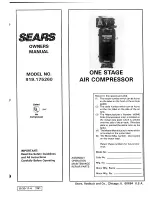
4.
MAINTENANCE
4.1.
Draining Air Tank.
4.1.1.
The frequency at which you should drain the air tank depends on the environmental
conditions and the amount of operating time logged.
4.1.2.
The average draining frequency is every two/three days.
4.1.3.
Place the air compressor above a container capable of holding water.
4.1.4.
With compressed air in air tank, slowly turn the drain valve knob anti-clockwise. The
water in the air tank will drain out.
4.1.5.
After all of the accumulated water has drained out, turn the drain valve knob
clockwise until it is tight, this will avoid leakage.
4.2.
Changing the air filter.
4.2.1.
The air filter is designed to reduce noise and help dust particles form entering and
damaging the air compressor.
4.2.2.
After being used for a period of time, the air filter will become clogged. This will
reduce the air intake capabilities of the air compressor, reducing performance,
therefore the air filter must be replaced regularly.
4.2.3.
Open the lid on the air filter, then remove old filter.
4.2.4.
Replace it with a new filter, then close the lid.
4.3.
Testing for leaks.
4.3.1.
Make sure all connections are tight but be careful not to overtighten.
4.3.2.
A small leak in any hose or pipe connection will reduce the air compressors
performance.
4.3.3.
To test for small leaks spray a small amount of soapy water on suspected area of
leakage. If soap solution bubbles, tighten or replace part/s.
4.4.
Cleaning.
4.4.1.
Clean items with a soft brush, or wipe with a moistened cloth using a biodegradable
cleaner.
4.4.2.
Do not use flammable liquids such as petrol or alcohol. Always keep parts clean from
dirt and dust for a better performance.
4.5.
Adjusting the pressure switch.
4.5.1.1.
The pressure switch should only be adjusted by suitably qualified persons.
Page 11
Ver 2
Summary of Contents for HY0808
Page 1: ......


































